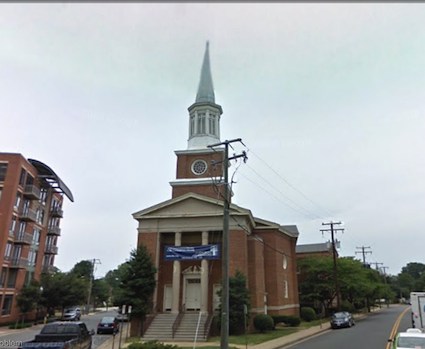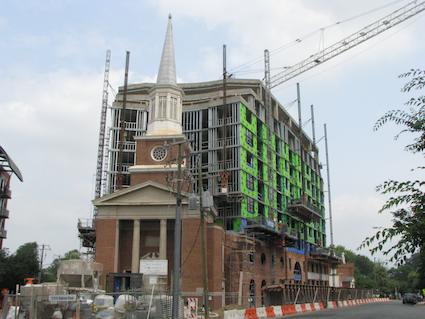I can’t tell if I live in an area overflowing with geo-oddities or whether my personality reflexively uncovers unusual situations wherever I happen to locate myself. Would I be equally adept at mining unusual patterns in London, Toronto, Sydney or Dakar? Perhaps. I’ve argued before that weirdness exists everywhere. Even so, my home area provides strange situations in great abundance and even now continues to add to them.
Going to Church
Behold the First Baptist Church of Clarendon in Arlington, Virginia. So I think you’ll agree that it looks fairly typical. Can you guess the weirdness associated with it without resorting to any of the search engines? Of course you can’t. It’s a complete paradox.

Historically, anyway, it was known as the First Baptist Church. I’m not sure if they are affiliated with a particular denomination any longer. They seem to have dropped the Baptist part of their name. That’s not particularly germane to the story, or perhaps it is; it’s hard to tell with everything that’s transpired over the last decade.
I lifted the image above from Google Street View, and that’s how it appears in their database today. Future readers may notice it change. It will look much different the next time a Street View car rolls by and updates its imagery.
Big Changes Afoot
I happened to walk past there a few days ago. I noticed that constructions was well underway.

The Church at Clarendon struggled with a dilemma that many churches face today: declining membership; aging infrastructure; increasing financial pressures and an uncertain future. However, the congregation did not follow the typical approach. The physical building is undergoing a metamorphosis that will create “The Views at Clarendon”. When completed, the church will be totally rebuilt with a ten-story apartment building incorporated into its design.
A quick examination of the local area reveals the seeds of the solution.
The Church, by fortunate coincidence, happens to be located on one of the few remaining parcels zoned for intensive development in a rapidly urbanizing corridor. The congregation faced financial pressures but it was sitting atop a fortune made of dirt. The land beneath their feet was incredibly more valuable than the structure rising above the surface. Many churches would have sold the property and rebuilt elsewhere, probably with enough cash left over to establish a nice endowment. That would have ensured financial solvency forever. But that’s not what happened here.
A Controversial Solution
The congregation entered into a triangular business relationship involving a developer and the state/local governments. This set-aside a sizable portion of the apartments for “affordable housing”. The congregation would gain a completely refurbished house of worship; the developer would receive significant tax breaks and low-interest loans; and the county would add 70 units to its list of affordable housing stock in an area where it had been diminishing. Everyone wins, right? Wrong.
The satellite image also reveals a justification for dissent. Notice all of the single family homes immediately adjacent to the church parcel. Their residents would now live in the shadow of a ten-story wall and their neighborhood would be the pressures of increased cut-through traffic and competition for parking. I don’t have enough facts to form an opinion so I will simply note that there were two completely separate positions.
The debate became heated and emotional. It devolved to all of the obvious inflammatory charges and counter-charges one could imagine, hurled equally by both camps (NIMBY, Socialism, Racism, Greed, etc.).
The county passed an initial plan in 2004. However, legal challenges were still underway as late as December 2010 when a judge on the Fourth Circuit Court upheld an earlier decision. Thus the court decided the project served a secular purpose and was not an entanglement between church and state.
Interestingly, this isn’t the only place in Arlington with an unusual church arrangement. Previously I featured a church with a gas station beneath it, just a couple of miles down the road. Are multipurpose churches a feature unique to the area or are they a more widespread indicator of land pressures in an urban environment? I’d love to know if other examples exist elsewhere.

Leave a Reply